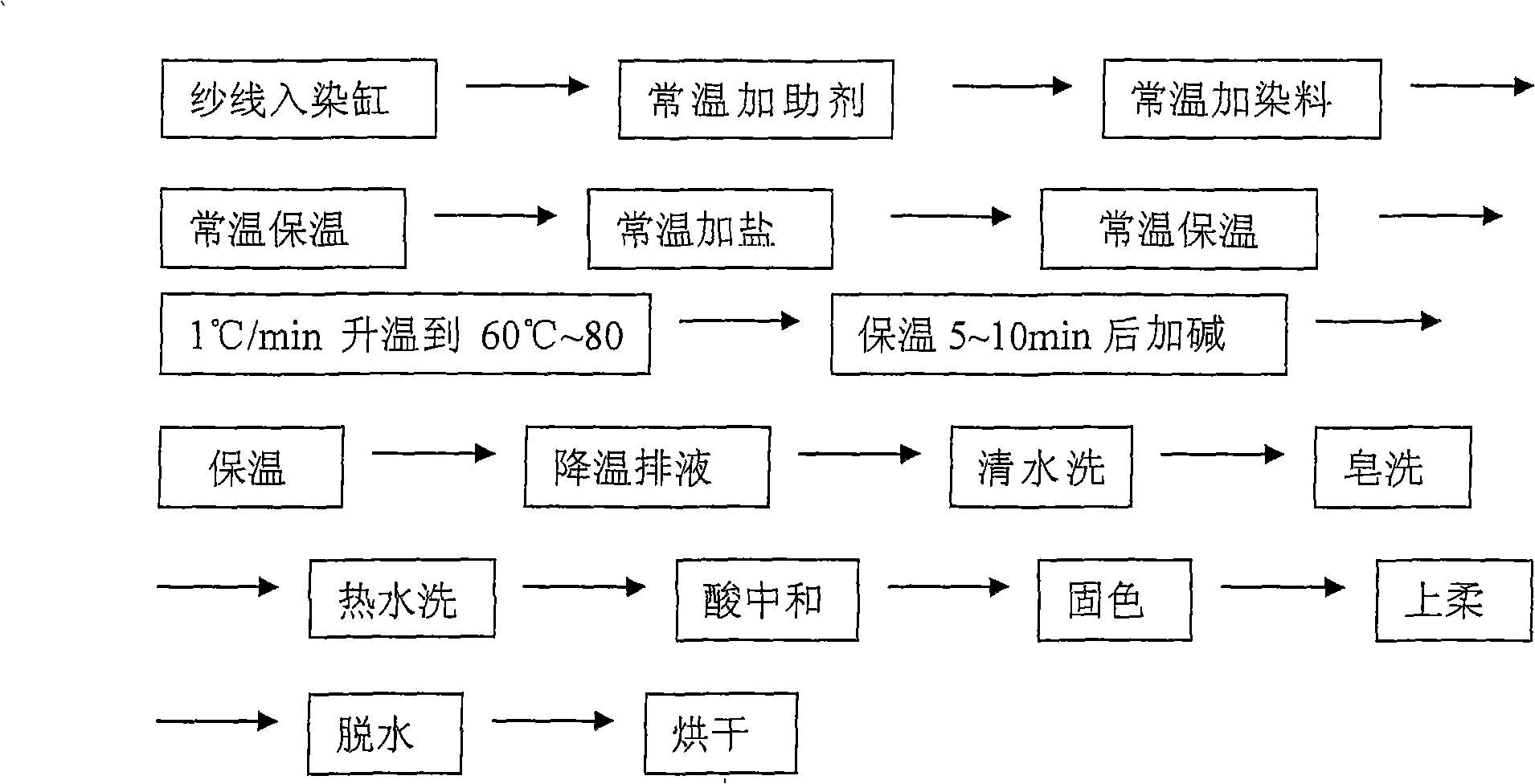Dyeing process for spun silk
A spun silk and process technology, applied in the field of spun silk dyeing technology, can solve the problems of reduced spun silk strength, reduced dyeing percentage, damage to spun silk fibroin, etc., and achieves improved breaking strength, reduced dyeing cost, and color fastness The effect of increasing
- Summary
- Abstract
- Description
- Claims
- Application Information
AI Technical Summary
Problems solved by technology
Method used
Image
Examples
Embodiment 1
[0025] It is 60S / 2 (double ply) with specification, and quantity is 300Kg, and dyeing color and luster is blue spun silk package yarn as example.
[0026] Please refer to figure 2 with image 3 . Firstly, loosen the commercially available 60S / 2 spun silk bobbins. The so-called loosening here refers to rewinding the spun silk yarns that were previously on the paper bobbin with a yarn rewinding device to enter the dyeing bobbin into the dyeing vat. The preferred but not limited yarn weight of each dyed bobbin is 0.8Kg, and the winding density is 0.38g / cm 3 , and then put the dyeing bobbin on the sarong, and lock the top lock.
[0027] Put the dyeing bobbin wrapped with spun silk in the sarong and put it into a semi-filled dyeing vat such as produced by Hong Kong Lixin Co., Ltd., fill the dyeing vat with water at a bath ratio of 1:8, that is, 1Kg of yarn is mixed with 8Kg of water, and then Start the dyeing circulation pump and add the product brand H54 chelating dispersant ...
Embodiment 2
[0029] It is 60S / 2 (two-ply) with specification, and quantity is 60Kg, and the spun silk package yarn that dyeing color and luster is dark green is example.
[0030] Please refer to figure 2 with Figure 4 . Firstly, loosen the commercially available 60S / 2 spun silk bobbins. The so-called loosening here refers to rewinding the spun silk yarns that were previously on the paper bobbin with a yarn rewinding device to enter the dyeing bobbin into the dyeing vat. The preferred but not limited yarn weight of each dyed bobbin is 0.9Kg, and the winding density is 0.39g / cm 3 , and then put the dyeing bobbin on the sarong, and lock the top lock.
[0031]Put the dyeing bobbin wrapped with spun silk in the sarong and put it into a semi-filled dyeing vat such as produced by Hong Kong Lixin Co., Ltd., and fill the dyeing vat with water. The bath ratio is 1:9.5, that is, 1Kg yarn is equipped with 9.5Kg water. Then start the dyeing circulation pump and add to the dye vat sequentially the...
Embodiment 3
[0033] It is 60S / 2 (double ply) with specification, and quantity is 800Kg, and dyeing color and luster is blue spun silk package yarn as example.
[0034] Please refer to figure 2 with Figure 5 . Firstly, loosen the commercially available 60S / 2 spun silk bobbins. The so-called loosening here refers to rewinding the spun silk yarns that were previously on the paper bobbin with a yarn rewinding device to enter the dyeing bobbin into the dyeing vat. The preferred but not limited yarn weight of each dyed bobbin is 1.0Kg, and the winding density is 0.40g / cm 3 , and then put the dyeing bobbin on the sarong, and lock the top lock.
[0035] Put the dyeing bobbin wrapped with spun silk in the sarong and put it into a semi-filled dyeing vat such as produced by Hong Kong Lixin Co., Ltd., fill the vat with water, the liquor ratio is 1:7, that is, 1Kg yarn is mixed with 7Kg water, and then Start the dyeing circulation pump and add the product brand H54 chelating dispersant produced a...
PUM
| Property | Measurement | Unit |
|---|---|---|
| density | aaaaa | aaaaa |
| density | aaaaa | aaaaa |
| density | aaaaa | aaaaa |
Abstract
Description
Claims
Application Information
 Login to View More
Login to View More - R&D
- Intellectual Property
- Life Sciences
- Materials
- Tech Scout
- Unparalleled Data Quality
- Higher Quality Content
- 60% Fewer Hallucinations
Browse by: Latest US Patents, China's latest patents, Technical Efficacy Thesaurus, Application Domain, Technology Topic, Popular Technical Reports.
© 2025 PatSnap. All rights reserved.Legal|Privacy policy|Modern Slavery Act Transparency Statement|Sitemap|About US| Contact US: help@patsnap.com



